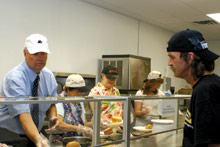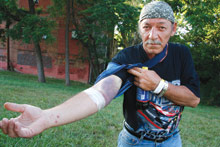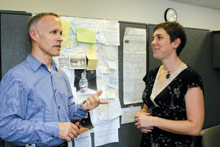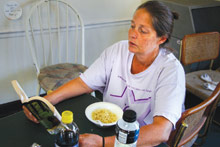It is, perhaps, a sign of the times: “People are asking us for food more than money or anything else,” says Amy Sawyer, coordinator of Asheville’s Homeless Initiative. “We’re seeing more families, more children, less of the habitually homeless. Some of them still have jobs, and things were tight before, but now they can’t pay their bills.”

And coming on the heels of a sharp cut in federal grants to community organizations this spring, the increased demand has left some of Asheville’s main social-service agencies scrambling to bridge the gap.
The Homeless Initiative is part of the city’s ambitiously named 10-Year Plan to End Homelessness. Sawyer, who works out of the Planning Department, serves as a liaison between city government and the various local agencies working on the problem.
Meanwhile, Mission Hospitals announced in May that it would pull back most of its support from the Asheville Buncombe Community Christian Ministry’s free clinic, starting in October. The Rev. Scott Rogers, ABCCM’s executive director, estimates that demand for his agency’s other services—especially for people on the verge of being out on the street—has also increased by about 20 percent. And with fuel costs up about 25 percent, Rogers says he expects demand to rise still further as winter approaches.
“There’s a crisis looming—we’re getting more requests for food and clothing every day,” he notes.
ABCCM isn’t the only local agency that’s having a hard time keeping up. In March, the city hit Zacchaeus House with a zoning violation, forcing the group to look for a new home. The nonprofit organization had operated a homeless shelter and church out of a house on South French Broad Avenue for 16 months. The free breakfasts the group used to hand out in Pritchard Park on Sunday mornings have also been noticeably absent of late.
Both Zacchaeus House and its founders, the Revs. Amy Cantrell and Chrystal Cook, are on sabbatical. “They’re taking some time to rest, reflect and decide where to go from here,” says the Rev. Chad Hyatt, who serves on Zacchaeus House’s board of directors.

Meanwhile, over at AHOPE on Ann Street, the city’s main homeless shelter, “We’re just trying to keep our head above water,” Director Gary Kovach reports. “We have about 275 to 300 pairs of shoes come through these doors every day.” And with the economic situation worsening, Kovach, too, anticipates still more people needing help.
“We haven’t seen it yet, but we know it’s coming.”
Common challenges
A key part of Sawyer’s work is coordinating the efforts of the various local agencies and seeing what common challenges they’re facing.
“We spend a lot of time talking to each other about these problems, so things don’t get out of control,” she explains. “We’re trying to make sure there are services in place to help people pay their bills, for example, so there’s less chance of people becoming homeless in the first place.”
Sometimes seemingly small steps can help address a larger problem, such as the increased demand for food. “It can just be something like convincing an agency to offer lunch as well as dinner,” says Sawyer.
One of the biggest problems right now, she says, is the steep decline in federal funding. “Across the board, federal funding for social services has been cut—including for services to the homeless. The good news is that while funding from some federal agencies is being cut, others are out there too. So [although] the block grants are down, there’s still other funding we’re going after.”
That includes federal, state and local sources, though Sawyer emphasizes that making up the shortfall isn’t easy.
“We’re looking to work with local and state agencies to get some of that back, along with building relationships with [groups] like America’s Road Home,” she says. The Denver-based national nonprofit is focused on ending family homelessness.

The Asheville Downtown Association’s Spare Change for Real Change program aims to provide some of that funding. Envisioned as an alternative to giving money to panhandlers, the program’s donation boxes are scattered around downtown. (A city ordinance bans panhandling throughout most of downtown, though Cantrell and other activists have criticized the law.)
Spare Change raised $10,000 last year, according to Adrian Vassallo, the association’s treasurer. “We’re taking applications right now to decide how to best disburse that—whether it will be one grant or several small ones,” he reveals. The applicants include the Affordable Housing Coalition and the Asheville Homeless Network, which is not a social-service agency but a membership organization for homeless people.
The boxes, however, are not the program’s main source of funds. “Those are mostly just a PR tool,” Vassallo explains. “A lot of local businesses put up matching funds to what we raise, or provide donations.”
This year, the Spare Change program has been bringing in about $400 a week all told, including grants and matching funds from businesses, Sawyer reports. Such local programs, she notes, “start to rack up after a while. We’re looking for everything we can to try to cover those [lost federal] funds.”
Trouble in the trenches
And with Mission Hospitals drastically reducing its support, ABCCM finds itself in a similar situation. In October, the hospital—which has provided more than half the funding for the ministry’s widely used free clinic—plans to scale back its commitment from more than $300,000 a year to $40,000.

The decision came after “we began rethinking the best way to help the uninsured,” spokesperson Janet Moore explains. Although Mission believes the free clinic does a “very good job at what we call ‘episodic care’—one-time treatments or incidents—the best thing to do is concentrate on primary care, which is more preventive, so there’s less strain on their clinic or on our emergency room.”
To that end, Mission plans to redirect the funding toward preventive medicine. The funding, says Moore, will be pulled back incrementally, “so that ABCCM can make up the revenue.”
Rogers, however, remains undaunted. In fact, he says, ABCCM is in the midst of adding 100 more beds for homeless veterans and another 20 to 30 general shelter beds, 10 of which will be set aside for the homeless.
“That’s a 110 net increase in the number of beds” available for the local homeless population, he notes.
The agency has also stepped up efforts to help people avoid becoming homeless in the first place—by helping them pay their rent and buy basic necessities.
“The turning point was last October,” says Rogers, adding, “We’ve had people coming to us left and right” since then.
Typically, it’s one of two situations, he continues. “The first is people who need help with [their] mortgage, they’re facing foreclosure; and the second is when the landlord’s costs go up, their rent goes up. That can really hurt people at the lower end. Even just a $40 to $50 increase in rent puts a lot of families on the edge.”
In response, ABCCM is trying to take “a very careful approach: making sure people don’t get out on the street in the first place; doing everything we can to get them the help they need. It’s very hard to get out of that cycle once it starts.”
AHOPE, meanwhile, is doing its best to “keep feeding and helping people, using our time and energy to try to make sure we don’t let people fall through the cracks.” But the local agency also tries to help its clients get assistance from other programs, such as food stamps, Medicaid or the Department of Veterans Affairs.
“We try to help walk them through it, fill out the forms and get what they need,” Kovach explains.
Coming together
“In the mountains, there’s always been a tradition of coming together and caring for each other when times are tough,” notes Rogers. “You can see that now.” That makes him hopeful that ABCCM can make up the substantial cut in Mission Hospitals’ support.
But though the community is continuing to show its generosity through donations of both money and help, he notes, “We’re heading for some pretty rough times.” Amid skyrocketing fuel costs, Rogers says he expects this winter to be particularly hard on the working poor, who are already just a paycheck or two away from homelessness.
Kovach, meanwhile, points to the cuts in federal grants as an example of how outside events can hamper even the best local efforts to cope with the homeless problem. Asked how people can help, he notes: “We do take volunteers. But keep an eye to November. All I can say to people is vote early, vote often.”
For her part, Sawyer concedes that the end of homelessness isn’t exactly around the corner. In March, the Homeless Initiative released the results of a “point-in-time” count, taken in January, which showed more than 500 homeless people on the streets of Asheville. Another such count is planned for late July. Earlier this year, Sawyer predicted that the worsening economy would result in a rise in the homeless population.
“People hear about the 10-Year Plan, but it’s really about a new community response—a strong network so we can respond to people’s needs in times like this, so that when people do fall into a bad way, it’s not forever.”



Before you comment
The comments section is here to provide a platform for civil dialogue on the issues we face together as a local community. Xpress is committed to offering this platform for all voices, but when the tone of the discussion gets nasty or strays off topic, we believe many people choose not to participate. Xpress editors are determined to moderate comments to ensure a constructive interchange is maintained. All comments judged not to be in keeping with the spirit of civil discourse will be removed and repeat violators will be banned. See here for our terms of service. Thank you for being part of this effort to promote respectful discussion.